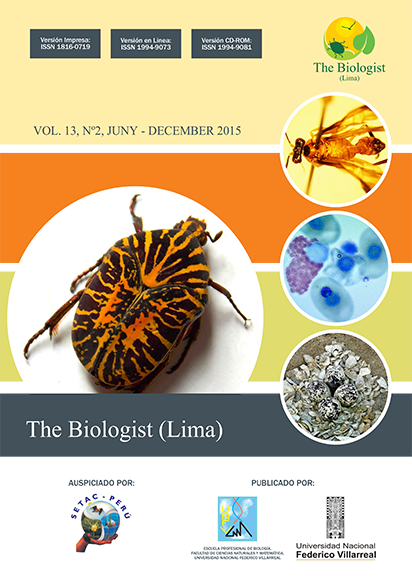CONVERGENCE ANALYSIS OF MAMMALIAN SPECIES OF WILDLIFE HABITATS AT HIGH ANDEAN HABITATS CALLED CCOLPAS, PUNO- PERU
DOI:
https://doi.org/10.24039/rtb2015132171Keywords:
Convergencia, ccolpas, especies, geofagía, hábitatAbstract
The main objective was to analyze and theorize the convergence of mammalian species of wildlife habitats of interest for resources (clay and water) called Ccollpas in Puno, Perú. The research was conducted in the hills Queñocota and Providencia, located in the district of Santa Lucia and Mazocruz, Puno Perú at an altitude of 4817 masl and 4850 masl. The study was conducted monthly from May to December 2011. Method of direct observation and intensive search for evidence (footprints, feces, feathers, hair, bone, nesting, roosting and dung) was
applied. We found evidence and observations of Puma concolor (Linnaeus, 1771) (footprints and
droppings), Lycalopex culpaeus (Molina, 1782) (excrement), Vicugna vicugna (Molina, 1782)
(individuals, excreements, remains of predation), Hippocamelus antisensis (D'Orbigny, 1834) (footprints and excrements), Lepus europaeus (Pallas, 1778) (feces), Tinamotins pentlandii (Vigors, 1837) (footprints and feathers). We determined that there is a greater visit to the area T. pentlandii and H. antisensis while the P. concolor footprints and excrement has been found in the surrounding area. We conclude that convergence of wildlife species in highlands is due to the existence of potential resources that complement their diet with minerals and influence on the reproductive process, also they can act as an antacid and other species benefit of it as hunting areas. This convergence of several species of high andean wildlife, several in vulnerable situation, can raise important habitat protection strategies for the conservation of wildlife and to
the functioning of ecosystems.
Downloads
Published
How to Cite
Issue
Section
License
Copyright (c) 2015 The Biologist

This work is licensed under a Creative Commons Attribution-NonCommercial-NoDerivatives 4.0 International License.
Objeto: El AUTOR-CEDENTE transfiere de manera TOTAL Y SIN LIMITACIÓN alguna al CESIONARIO (Revista The Biologist (Lima)) los derechos patrimoniales que le corresponden sobre sus obras por el tiempo que establezca la ley internacional. En virtud de lo anterior, se entiende que el CESIONARIO adquiere el derecho de reproducción en todas sus modalidades, incluso para inclusión audiovisual; el derecho de transformación o adaptación, comunicación pública, traducción, distribución y, en general, cualquier tipo de explotación que de las obras se pueda realizar por cualquier medio conocido o por conocer en el territorio nacional o internacional.
Remuneración: La cesión de los derechos patrimoniales de autor que mediante este contrato se hace será a título gratuito.
Condiciones y legitimidad de los derechos: El AUTOR-CEDENTE garantiza que es propietario integral de los derechos de explotación de la(s) obra(s) y en consecuencia garantiza que puede contratar y transferir los derechos aquí cedidos sin ningún tipo de limitación por no tener ningún tipo de gravamen, limitación o disposición. En todo caso, responderá por cualquier reclamo que en materia de derecho de autor se pueda presentar, exonerando de cualquier responsabilidad al CESIONARIO.
Licencia de acceso abierto: El AUTOR-CEDENTE autoriza que manuscrito publicado en la Revista Científica The Biologist (Lima) (versión Impresa ISSN 1816-0719, versión en línea ISSN 1994-9073) permanece disponible para su consulta pública en el sitio web http://revistas.unfv.edu.pe/index.php/rtb/index y en los diferentes sistemas de indexación y bases de datos en las que la revista tiene visibilidad, bajo la licencia Creative Commons, en la modalidad Reconocimiento-No comercial- Sin Trabajos derivados –aprobada en Perú, y por lo tanto son de acceso abierto. De ahí que los autores dan, sin derecho a retribución económica, a la Escuela Profesional de Biología, Facultad de Ciencias Naturales y Matemática de la Universidad Nacional Federico Villarreal (EPB - FCCNM - UNFV), los derechos de autor para la edición y reproducción a través de diferentes medios de difusión.









































